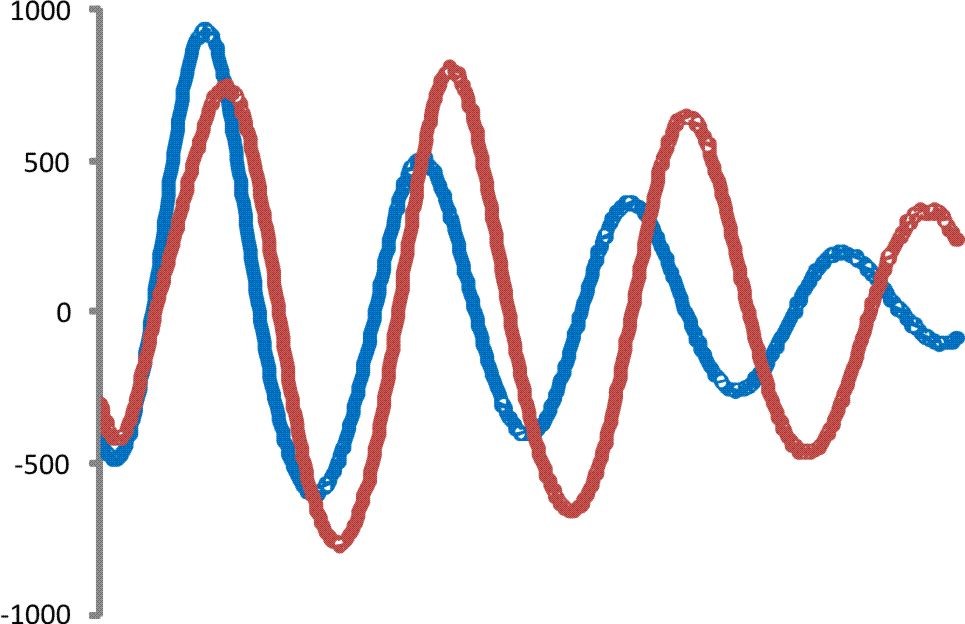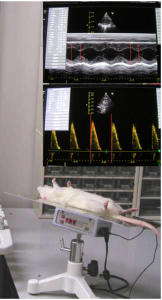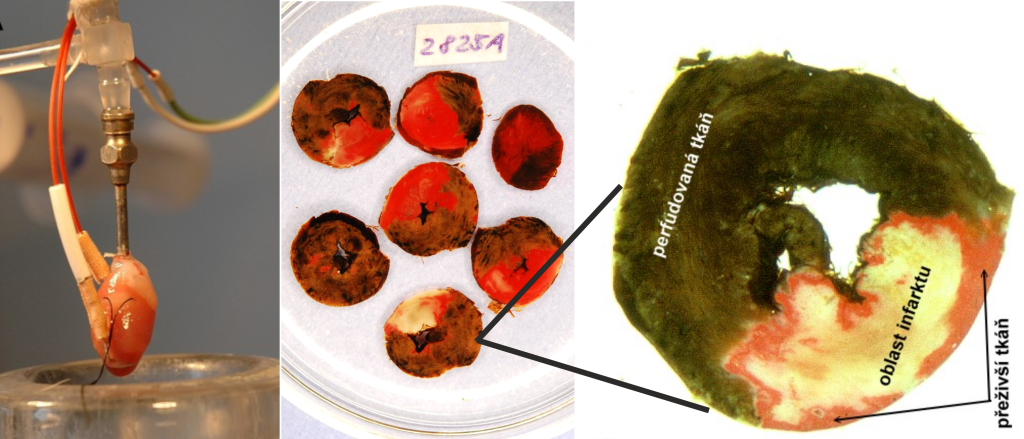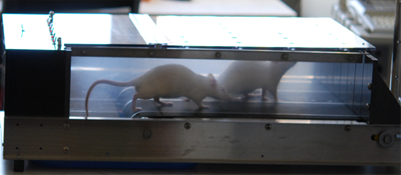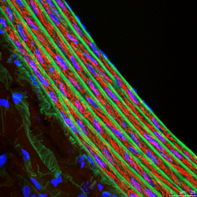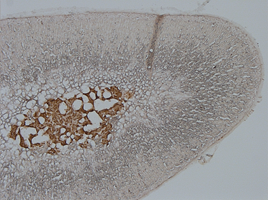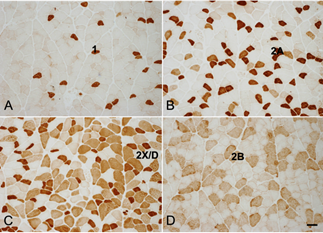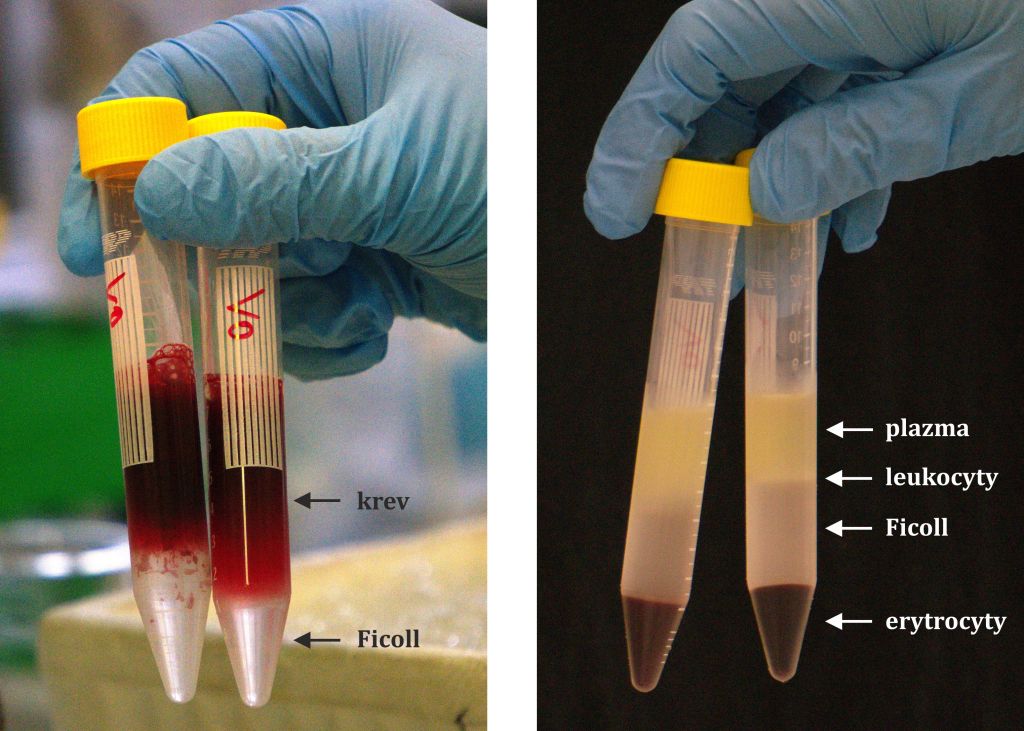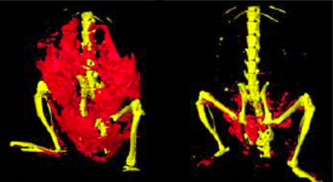Studied Diseases

Content of this page

Our research is focused on investigating the genetic origin of severe human diseases as well as explaining their pathogenesis. We aim to improve diagnostic techniques and to develop new methods for both efficient treatment and prevention.
Brain
Disorders of Biorhythms
Our genes determine whether we are rather an early bird or an owl. If we do not live in accordance with our inner rhythm, our health can be in danger.
Therefore, we study molecular adjustment of our inner biological clock under the influence of external time and also health problems resulting from a defect of this process. We also investigate disorders of time regulation at various psychiatric and neurological diseases that are accompanied by sleep disorders (e.g. bipolar disorder, Alzheimer’s disease, hypersomnia).
Daily rhythmical expression of clock gene Bmal1 measured in fibroblast cultures from skin biopsies of two healthy volunteers. The rhythm runs faster, i.e. with a shorter period, in the volunteer depicted in blue compared to the volunteer depicted in red. Details at the website of Department of Neurohumoral Regulations.
Scientific laboratories
LABORATORY OF BIOLOGICAL RHYTHMS
Alzheimer's Disease
According to recent research, the primary cause of the disease is represented by an increase in the production of ß-amyloid polypeptides. They then gradual polymerize and form amyloid plaques that are characteristic histopathologic feature of this disease. The cause of increased production of ß‑amyloid is known only for familial forms of the disease, but these represent only a tiny fraction (1–2 %). The presence of apolipoprotein E4 (ApoE4) is the most prevalent genetic risk factor of Alzheimer’s disease. We study the cellular and molecular mechanisms underlying the neuronal and synaptic effects of apoE4 and their neuronal specificity since one of the characteristics of the disease is the damage to the cholinergic neurons.
Furthermore, we try to clarify processes underlying disorders of cognitive functions (e.g. memory, space orientation, and learning) that accompany Alzheimer’s disease.
Scientific laboratories
LABORATORY OF MOLECULAR NEUROBIOLOGY
LABORATORY OF NEUROCHEMISTRY
LABORATORY OF NEUROPHYSIOLOGY OF MEMORY
Neuropathic Pain
Pain usually warns us that there is a possibly damaging stimulation and that we need to act fast to prevent the damage to our body. However, the useful pain sometimes becomes pathologic.
The neuropathic pain, caused by injury or damage of peripheral or central part of nervous system, is characterized by abnormal pain perception – allodynia (pain is triggered by usually painless stimuli) and hyperalgesia (increased sensitivity to painful stimuli and more pronounced answers to them). There is often also spontaneous pain without any stimulation.
The mechanisms underlying the development of neuropathic pain are not completely understood. The neuropathic pain may be partially explained by pathophysiological changes after neuronal injury. However, it is often present as a symptom of another disease, such as diabetes, multiple sclerosis, heart attack, or cancer. Moreover, it can be triggered by drugs, viral infection, toxins, or even treatment (the neuropathic pain may appear as a side-effect of cytostatic treatment, which limits the use of cytostatic drugs for cancer therapy).
The common pain-killers are usually not efficient to suppress the neuropathic pain, which makes it only hardly treatable. Therefore, we study mechanisms of pain reception (nociception) under normal and neuropathic conditions to better understand mechanisms of neuropathic pain and develop more efficient therapy.
Scientific laboratories
LABORATORY OF PAIN RESEARCH
Depression
Mood disorders, and mainly depression, belong to the most frequent and life-complicating mental diseases.
The cause of depression and mechanisms of its development have not been completely clarified. There are probably genetic, endocrinal, and also nutritional influences. Patients suffering from depression are characterized by physiological, histological, and morphological changes in their brain.
There are many potent antidepressants. According to clinical studies, however, the therapeutic response is insufficient at 30–50 % patients and moreover, the first therapeutic effects appear not earlier than after several weeks or even months of treatment. Our research into this field thus focuses on searching for chemical compounds with a faster effect as well as on shedding light on the mechanism of their action.
Scientific laboratories
LABORATORY OF NEUROPHYSIOLOGY OF MEMORY
Schizophrenia
Schizophrenia is a very severe neuropsychiatric disease whose first symptoms appear in the period of adolescence or early adulthood.
Its symptoms belong to 3 groups:
- positive (hallucinations, delusions)
- negative (emotional lethargy, inability to experience positive feelings – anhedonia)
- cognitive.
The cause of this disease has not been clarified. We study neurobiology of cognitive symptoms and mechanisms how antipsychotics affect these symptoms. Our results contribute to formation of a scientific view on schizophrenia that emphasizes the role of cognitive symptoms (attention disorders, decreased capability of making decisions and plans) in the development of this disease. The previous concept of schizophrenia regarded the disorder of cognitive functions only as a secondary symptom and/or as a side-effect of antipsychotic therapy.
How do we test cognitive functions of our animal models? In Morris’ water maze, we observe the ability of a rat to orientate itself in space and we measure how fast it learns to find an island hidden close under the water surface (on the left). Similarly in a rotating arena, a rat learns to avoid an allotted area where it is exposed to a weak electrical shock (on the right). Illustrations: Marie Entlerová
Scientific laboratories
LABORATORY OF NEUROPHYSIOLOGY OF MEMORY
Epilepsy
Epilepsy is one of the most frequent brain diseases since it affects 1 % of population. The first seizure may be triggered by a variety of events in brain – injury, bleeding, infection, or ischemia.
The seizure results in brain damage and triggers some epileptogenic alterations that cause occurrence of spontaneous and repeated seizures. These seizures define epilepsy. As a consequence of brain alterations at the molecular, structural, and also functional level, epilepsy is accompanied by
- disorders of cognitive functions that include e.g. recognition, memory, learning, and adapting to unstable environment
- alterations of psychomotor development
- neuropsychiatric symptoms
Understanding of mechanisms underlying the creation of seizures is important to develop a treatment for epilepsy. Therefore, we study the beginning, spreading, and suppression of epileptic activity in adult as well as immature brain. We also investigate consequences of an early brain damage and mechanisms underlying this damage.
Development of motor skills of a rat during early developmental phases can be negatively affected by epileptic activity.
Scientific laboratories
LABORATORY OF DEVELOPMENTAL EPILEPTOLOGY
Heart
Cardiac Arrhythmias
In the civilised world, cardiovascular diseases are the most frequent cause of death. The more the population ages, the more frequent cardiac arrhythmias are.
Their incidence is probably going to rise in the future. Unfortunately, the cause of arrhythmia is unknown in most cases and their origin is not sufficiently explored. We focus on a possible origin of arrhythmias in an abnormal heart development from the molecular to the organ level. The development of electrical conduction system of the heart plays the key role. Defects in its function during the ontogenesis lead to defective production of action potentials and slowed-down or completely disconnected signal transmission through individual parts of heart. This is the cause of a significant number of arrhythmias.
Chicken embryo is a convenient model for studying cardiac arrhythmias. On the left: a chicken embryo cultivated in a plastic dish during the echocardiographic examination. In the middle: a video recording from an open egg at a 4-day old embryo (ED4). On the right: a micro-ultrasound recording of an 8-day old embryo (ED8).
Scientific laboratories
LABORATORY OF DEVELOPMENTAL CARDIOLOGY
Chronic Heart Failure
The incidence of chronic heart failure is skyrocketing in Europe. This epidemic has multiple reasons: aging of population, decreased mortality due to cardiac disorders, and wide spreading of metabolic risks – obesity and diabetes.
We study the connection of metabolic disorders and heart failure at a variety of model rat strains. The failing heart is unable to execute its function, i.e. pumping blood to the whole body, and it is, therefore, necessary to implant a ventricular assist device or even transplant the heart. We analyse samples from patients undergoing the heart transplant to investigate whether there is a connection between heart failure and mitochondrial defects because mitochondria are the key energy producers in cells. Simultaneously, we search for both characteristic markers for identification of new patients and potential targets for treatment.
A failing rat heart can be distinguished from a healthy rat heart by electrocardiography (ECG). During this examination, the rat is under a complete narcosis.
Scientific laboratories
LABORATORY OF BIOENERGETICS
LABORATORY OF GENETICS OF MODEL DISEASES
LABORATORY OF DEVELOPMENTAL CARDIOLOGY
Ischemic Heart Disease
The development of ischemic heart disease results from a decreased blood flow through the myocardium, usually caused by arteriosclerosis. The myocardium suffers from ischemia (insufficient blood supply) and consequently, insufficient oxygen supply. The end stage is then infarction (heart attack).
In order to improve the treatment of ischemic heart disease and thus the prevention of heart attack, we study the mechanisms that play a role in the resistance of myocardium to the damage caused by hypoxia (oxygen deprivation). We investigate an increased myocardial resistance to ischemia, both innate at neonatal heart and artificially induced. There are 2 ways how to stimulate the myocardial resistance to ischemia – either adaptation to chronic hypoxia or physical exercise. On contrary, we also study animal models with pathologically enhanced sensitivity to ischemic damage due to the presence of various forms of systemic hypertension and dyslipidaemia (increased levels of lipids or lipoproteins in the blood plasma).
Studying an isolated perfused rat heart, we can monitor perfusion (flow) through myocardial blood vessels and estimate histochemically the size of area of infarction.
Physical exercise represents a way how to stimulate the resistance of heart to ischemia. Rats are running on a threadmill.
Scientific laboratories
LABORATORY OF DEVELOPMENTAL CARDIOLOGY
Hypertension
Hypertension (high blood pressure) is one of the civilisation illnesses that accompany unhealthy lifestyle and spreading obesity.
Furthermore, genetic predispositions and increasing age of population play a role. Untreated hypertension can lead to other disorders of cardiovascular system (atherosclerosis, stroke, or ischemic heart disease).
In order to explain the development of hypertension, we study rats harbouring both genetic and experimental forms of this disease. We investigate effects of exogenous factors in combination with genetic predispositions during the ontogenetic development. We also try to describe mechanisms of vascular contraction and the role of vasoconstriction and vasodilatation systems in the regulation of blood pressure.
Aorta section: alpha-actin detected with a specific antibody (red), cell nuclei (blue), autofluorescence (green).
This adrenal section shows tyrosine hydroxylase in adrenal medulla, which is an enzyme that catalyses the key reaction of catecholamine synthesis. Catecholamines are hormones that contribute to the regulation of blood pressure.
Scientific laboratories
LABORATORY OF EXPERIMENTAL HYPERTENSION
LABORATORY OF GENETICS OF MODEL DISEASES
Metabolism
Bone Marrow Diseases
Scientific laboratories
Laboratory of Molecular Physiology of Bone
Yeast Infection (Candidosis)
One of the most frequent agents that cause yeast infections are yeasts of the Candida genus. They are a common constituent of human microflora. In the case of weakened immune system (as a consequence of AIDS, organ transplants, or chemotherapy), they become life-threatening pathogens.
We got ahead of bacteria by discovering penicillin and then developing a variety of antibiotics, which simplified our fight against bacterial infections. Developing of antimycotics is much more complicated because yeast and human cells are both cells eukaryotic. Therefore, they are very similar and it is not easy to find a chemical compound that would eradicate selectively only yeast cells and not affect human cells. Fortunately, pathogenic yeasts of the Candida genus contain some transporters in their membranes whose both structure and activity are different from the membrane transporters in human cells. We study these transporters because they could be used as targets of new types of antimycotics.
Scientific laboratories
Laboratory of Membrane Transport
Cancer
The Czech Republic is characterized by the highest incidence of colorectal carcinoma.
Colorectal carcinoma probably starts with impairment of gut epithelium by unhealthy lifestyle and bad nutrition. One of the risk factors is, according to the World Health Organisation, also shift work. Using a mouse model, we study how
- the impairment of inner biological clock
- the impairment of natural rhythm day/night
- and the unhealthy exposure to the light during night periods
contribute to the development of colorectal carcinoma. Understanding of the mechanisms that connect the circadian clock and cell cycle regulation in the process of carcinogenesis is important for the prevention (avoiding damaging influences in the environment) as well as treatment.
In general, cancer cells typically alter their energy metabolism. Therefore, we also study specific bioenergetic features of cancer cells, which is the first step on the path to finding a treatment for cancer.
A sample of colorectal carcinoma is obtained by laser microdissection from a histological preparation of gut epithelium.
Scientific laboratories
LABORATORY OF MEMBRANE TRANSPORT
Laboratory of Biological Rhythms
Muscle Atrophy
Compounds that would stop faltering of unused muscles could be beneficial for elderly people, bedridden patients, or astronauts during long-term space missions.
One of the muscles that falters the most for example in the state of weightlessness is the soleus muscle (Musculus soleus). It belongs to the so-called antigravity muscles that stabilise our body in the erect position.
Muscle atrophy is however influenced by tens of genes, so it will be difficult to develop efficient drugs affecting their functions. The first step is understanding of mechanisms that regulate the muscle development. Therefore, we study the combination of genetic predispositions and exogenous factors and its effect on the production of specific muscle proteins that determine the types of muscle fibres.
For the study of cardiac and skeletal muscles, histochemical and immunocytochemical staining of tissue sections is used. On the picture, skeletal muscle sections stained for specific muscle proteins enable us to analyse different muscle fibre types.
Scientific laboratories
Laboratory of Pain Research
Inherited Metabolic Disorders
Mitochondria are cell organelles that play the role of a predominant energy producer at the molecular level.
To study mitochondria, we use both animal models and cells derived from patients suffering from various inherited mitochondrial disorders. Mitochondrial disorders manifest themselves as energy deprivation, especially in heart, muscle or brain that are all tissues with high energy demands. Therefore, many mitochondrial disorders are diagnosed as cardiomyopathies or encephalopathies.
We develop procedures for the diagnostics of mitochondrial disorders for clinical practice. From the patient point of view, our greatest improvement lies in the use of blood samples. Taking a blood sample is significantly less painful in comparison to a muscle or skin biopsy that has been used for the diagnostics so far.
Isolation of lymphocytes starts with layering of patient blood above the density medium Ficoll. During centrifugation, individual blood cell types sediment according to their size – erythrocytes are at the bottom, then there is the Ficoll layer and leukocytes above it (they are too large to go through Ficoll to the tube bottom). Above leukocytes (the majority of them are lymphocytes), there is blood plasma.
Scientific laboratories
Laboratory of Bioenergetics
Type 2 Diabetes
Diabetes mellitus type 2 (adult-onset diabetes) is one of the most important components of metabolic syndrome.
Unhealthy lifestyle contributes to the development of type 2 diabetes that is characterized by an increased level of blood sugar and inability of tissues to consume this sugar. The reason is that organs are no longer sensitive to the hormone insulin (so-called insulin resistance). After eating, insulin normally suppresses sugar synthesis in liver and stimulates, on contrary, depositing of sugar in liver and muscles. Therefore, the treatment aimes to improve insulin sensitivity of tissues. There are 2 ways to achieve this – a change of lifestyle or administration of drugs. We participate in developing of new chemical compounds.
Scientific laboratories
Laboratory of Adipose Tissue Biology
Laboratory of Membrane Transport
Laboratory of Pancreatic Islet Research
Obesity and Metabolic Syndrome
The combination of long-term consumption of excess food and absence of exercise, which is very common today, seriously impairs the energy balance in our organism.
The excess energy is stored predominantly in the form of lipids in the adipose tissue. Simultaneously, there is an increase in the lipid level in other tissues and also in the blood. Therefore, obesity is usually connected with a complex of other health disorders referred to as metabolic syndrome. Some of these diseases are studied at our institute in detail (e.g. hypertension, arteriosclerosis, insulin resistance, type 2 diabetes).
While searching for a treatment for obesity, we pay attention to the white adipose tissue and the possibility to stimulate the break-down of lipids in this tissue. We study especially the effect of ω-3 polyunsaturated fatty acids (ω-3 PUFA) that are contained in fish oil. Understanding of how these fatty acids affect our metabolism could improve their use for prevention and treatment of obesity.
Obese mice serve us as an experimental model for studying obesity. Computer tomography for small animals (μCT) enables us to compare fat depots of slim and obese mice (fat – red, bones – yellow).

